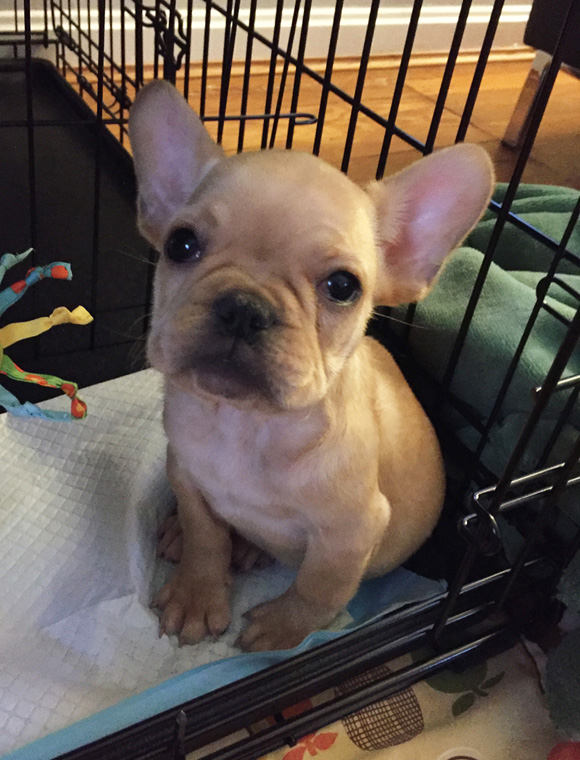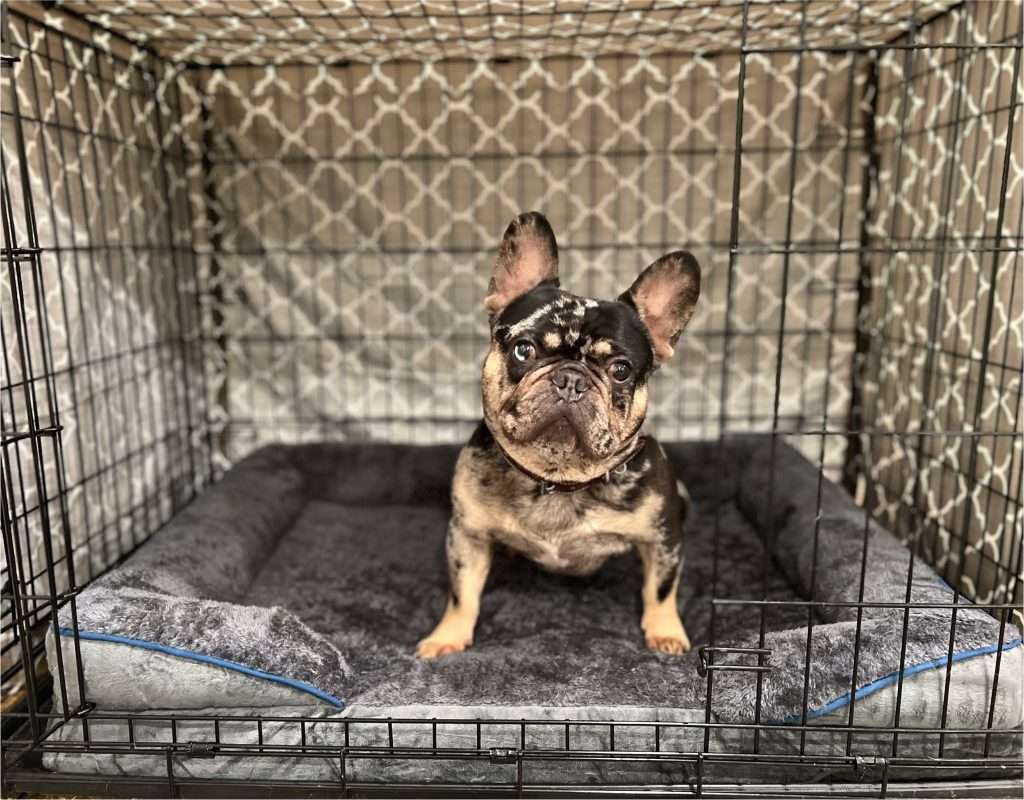Key Takeaways
Choose a crate that allows your French Bulldog puppy to stand, turn, and lie down comfortably.
Create a welcoming crate environment with soft bedding and safe toys.
Introduce your puppy to the crate gradually to build a positive association.
Manage nighttime anxiety by staying calm and consistent with your routine.
Expect to take your puppy out for potty breaks during the night and be prepared for some sleep disruption initially.
The Right Crate for Your French Bulldog
Before diving into the training process, it’s important to select the right crate for your French Bulldog puppy. The size of the crate is crucial—it should be large enough for your puppy to stand up, turn around, and lay down comfortably, but not so large that they can relieve themselves at one end and sleep at the other. A crate with a divider is a good choice, as it can be adjusted as your puppy grows.
Material-wise, you have a few options, such as wire, plastic, or soft-sided crates. Wire crates often provide better ventilation and include dividers, while plastic crates are cozier and more enclosed. Soft-sided crates are lightweight and portable, but may not stand up to a teething puppy’s chewing. Consider your puppy’s needs and your lifestyle when making a choice.

Creating a Comforting Crate Environment
To make your puppy’s crate a place they want to be, create a comfortable and inviting environment. Here’s how:
Place soft bedding inside the crate to make it cozy.
Include a chew toy to keep your puppy occupied.
Consider adding a blanket over the top of the crate to create a den-like atmosphere.
Keep the crate in a quiet area of your home to minimize disturbances.
Place the crate near your bedroom at night so your puppy can feel your presence.
Consider adding a cuddle pup like Snuggle Puppy. This adorable plush toy is designed to mimic the comforting heartbeat and warmth of a real puppy, providing your Frenchie with a soothing companion during crate time. It’s perfect for helping your pup feel secure and less anxious, making their crate a cozy retreat they’ll love to snuggle into.
Remember, the goal is for your puppy to view the crate as their personal haven, not a place of isolation or punishment. A positive environment will ease the training process significantly.
The First Night
The first night with your French Bulldog puppy can set the tone for future nights, so it’s important to start off on the right paw. Prepare the crate in advance, and introduce your puppy to it slowly throughout the day. Let them explore the crate with the door open, encouraging them with treats and praise.
When bedtime arrives, follow a calm evening routine to help your puppy wind down. This might include a gentle play session, a potty break, and some cuddle time. Once it’s time to sleep, guide your puppy into the crate with a treat and a soft, encouraging voice.
Easing Into the Evening Routine
Creating a consistent evening routine is key to successful crate training. Consistency helps your puppy understand what to expect, reducing anxiety and promoting a sense of security. Here’s a simple routine you might follow:
Dim the lights and reduce noise to signal that it’s time to calm down.
Take your puppy outside for a final potty break.
Place your puppy in the crate with a treat and a gentle pet.
Quietly leave the room, keeping goodbyes brief and unemotional.
It’s important to stay calm and collected during this process. Your puppy can pick up on your emotions, so if you’re anxious, they might be too.
Techniques for Addressing Anxiety and Distress in French Bulldog Puppies During Nighttime Crate Training
It’s normal for puppies to feel anxious on their first night in a new environment, and they may express this through whining or crying. While it can be heart-wrenching to hear, it’s important to resist the urge to rush in and comfort them, as this can reinforce the behavior.
| Technique | Description |
|---|---|
| Gradual Introduction | Start by leaving your puppy alone in the crate for short periods and gradually increase the time as they get more comfortable. |
| Positive Reinforcement | Use treats, toys, and praise to create a positive association with the crate. Reward your puppy each time they enter the crate voluntarily. |
| Comfort Items | Add blankets or toys that smell like home inside the crate to make it more comfortable and familiar. |
| Consistent Routine | Establish a consistent bedtime routine that includes a potty break before crating. This helps the puppy understand what to expect and reduces anxiety. |
| Crate Placement | Place the crate in a room where the family spends a lot of time, such as the living room or bedroom, to help the puppy feel less isolated. |
| Covering the Crate | Covering the crate with a blanket can create a den-like environment that feels safe and secure for the puppy. |
| Nighttime Potty Breaks | Take the puppy out for a quick potty break in the middle of the night if they whine, but avoid turning on lights or engaging in play to keep them calm and focused on the task. |
| Gradual Transition | If the crate is initially placed near your bed, gradually move it away over several nights to help the puppy adjust to sleeping alone. |
| Professional Help | If the puppy shows severe resistance or fear, consider seeking help from a professional trainer who specializes in handling such cases. |
| Patience and Consistency | Be patient and consistent with the training process. Every puppy learns at its own pace, and maintaining a calm and confident demeanor can help ease their anxiety. |
Instead, wait until your puppy settles down before checking on them. You can speak to them in a soothing tone or place a hand on the crate to reassure them, but avoid letting them out while they’re whining. Patience and consistency are your best tools here. For more guidance, check out these behavior management training tips for your French Bulldog.
Overnight Potty Breaks and Timing
Young puppies have small bladders and will need to go outside to potty during the night. Plan for this by setting an alarm for every few hours, and calmly take your puppy out to their designated potty area. Keep these trips business-like—no play or excessive talking—to reinforce that nighttime is for sleeping, not play.
As your puppy grows and their bladder control improves, you can gradually extend the time between potty breaks. Most importantly, always praise your puppy for doing their business outside, as positive reinforcement is key to successful potty training.
Progressive Training
As you and your French Bulldog puppy advance through the crate training process, it’s crucial to take things one step at a time. Pushing your puppy too fast can lead to setbacks, so it’s all about finding the right balance and gradually increasing their comfort level with spending time alone in the crate at night.
Gradually Extending Alone Time
Start by leaving your puppy in the crate for short periods while you’re still in the room, then gradually leave the room for a few minutes at a time. As your puppy becomes more accustomed to the crate, you can start stepping out of sight for longer stretches. This incremental approach helps build their independence and reduces the likelihood of separation anxiety.
Remember to return to the crate before your puppy becomes anxious and starts whining. This timing is key, as it reinforces the idea that the crate is a safe place, and you will always return. Keep extending the time as your puppy shows they can handle it.
Responding to Middle-of-the-Night Whimpers
If your puppy whimpers in the middle of the night, it’s often a sign they need to go potty. However, it’s also possible they’re feeling anxious or lonely. Listen carefully to determine if it’s a potty whimper or one for attention. For potty breaks, keep the interaction quiet and soothing, then return your puppy to the crate without fuss.
If it’s attention-seeking behavior, wait until the whimpers subside before checking in. Consistency is essential; if you respond to whining with attention or letting them out of the crate, your puppy will learn that whining equals reward.
Example: If your puppy starts to whimper at 2 AM, check the last time they went out for a potty break. If it’s been a few hours, it’s likely they need to go. If they just went out before bedtime, they might just be testing boundaries or feeling lonely.
Crate Training and Feeding Schedule
Aligning your puppy’s feeding schedule with crate training can aid in establishing a routine and minimizing nighttime potty breaks. Here’s a simple guideline:
Feed your puppy their last meal of the day a few hours before bedtime.
Allow for playtime and a potty break after eating to ensure they’ve emptied their bladder and bowels.
Avoid giving water right before bed to help them last through the night without a potty break.
Sticking to a feeding schedule not only helps with potty training but also sets a predictable daily rhythm for your puppy, making them feel more secure and less anxious.
Common Setbacks and How to Overcome Them
Even with the best-laid plans, you may encounter some challenges while crate training your French Bulldog puppy. It’s completely normal, and with patience and consistency, you can overcome these setbacks.
Dealing with Accidents
Accidents are a normal part of the crate training process, especially with puppies who are still developing bladder control. If an accident happens:
Clean it up promptly with an enzymatic cleaner to remove the scent and discourage repeat offenses.
Reassess your potty break schedule to see if it needs to be adjusted.
Never punish your puppy for accidents, as this can lead to fear and anxiety associated with the crate.
Understanding that accidents are a learning opportunity rather than a step back will help you maintain a positive outlook throughout the training process.
Separation Anxiety Strategies
Some puppies may develop separation anxiety, becoming distressed when left alone. To help alleviate this:
Practice short separations throughout the day to get them used to being alone.
Leave a piece of clothing with your scent in the crate for comfort.
Consider a white noise machine or a ticking clock to provide soothing background noise.
If separation anxiety persists, consult a professional trainer for personalized advice and strategies tailored to your puppy’s needs.
Adjusting Your Approach Based on Your Pup’s Personality

French Bulldog Crate Size from lepepitefrenchies.com
Every puppy is unique, and what works for one may not work for another. Pay close attention to your French Bulldog’s personality and adjust your training approach accordingly. Some puppies may need more reassurance and shorter training sessions, while others may be more independent and adjust quickly.
Be flexible and patient, and don’t hesitate to slow down the training if your puppy seems overwhelmed. The key is to make crate training a positive experience, not a source of stress.
Maintaining Consistent Training and Expectations
Consistency is the cornerstone of successful crate training. Stick to your routine, use the same commands, and maintain the same expectations every night. Consistency helps your puppy understand what’s expected of them and provides a sense of security.
The Role of Daytime Training in Nighttime Success
Don’t overlook the importance of daytime crate training. Encourage your puppy to spend time in the crate during the day, both with you at home and while you’re away. This helps reinforce the crate as a safe place and eases the transition to spending nights there.
Use treats, praise, and their favorite toys to make daytime crate experiences positive. This will translate into a more relaxed and confident puppy when it’s time to settle down for the night.
Creating Positive Crate Experiences Throughout the Day
Here are some tips for creating positive crate experiences:
Feed your puppy meals in the crate to create a positive association.
Randomly place treats in the crate for your puppy to find throughout the day.
Use the crate as a quiet time space after play to help them wind down.
By making the crate a rewarding place to be, you’re not only training your puppy for the night but also for any time they need to be crated, whether it’s for safety, travel, or as part of their daily routine.
When to Seek Professional Advice
If you’ve tried the above strategies and you’re still facing challenges, it may be time to seek professional advice. Persistent whining, anxiety, or destructive behavior can indicate underlying issues that require expert intervention. A professional dog trainer or behaviorist can provide personalized guidance and support to ensure you and your French Bulldog are on the right track. Find a Local Trainer here: https://dogtrainingelite.com/locations
Remember, seeking help is not a sign of failure. It’s a proactive step towards ensuring a happy and healthy relationship with your furry companion. Professional trainers can offer insights and techniques that are tailored to your puppy’s individual temperament and your specific situation.
Additionally, if you notice any signs of distress that seem out of the ordinary, such as refusal to eat, excessive salivation, or a drastic change in behavior, consult your veterinarian to rule out any medical issues.
Frequently Asked Questions (FAQ)
What is the Best Age to Start Crate Training a French Bulldog Puppy?
The best age to start crate training is as soon as you bring your puppy home, usually around 8 to 10 weeks old. At this young age, puppies are more adaptable and can quickly learn to accept the crate as a safe space. Starting early also helps with housebreaking and preventing destructive behavior.
However, it’s never too late to start. Older dogs can also be successfully crate trained with patience and positive reinforcement.
How Many Hours a Night Should a Puppy Stay in a Crate?
Generally, puppies can control their bladder one hour for every month of age. So, a two-month-old puppy might need a potty break every two hours. As they grow older, they can stay in the crate longer. Most puppies can sleep through the night without a potty break by the time they’re about 4 to 6 months old.
Should the Crate Be in Our Bedroom or a Separate Room?
During the initial stages of crate training, it’s beneficial to keep the crate in your bedroom. This allows you to respond quickly to potty needs and provides comfort to your puppy. Once they’re comfortable with the crate and sleeping through the night, you can gradually move it to a separate room if desired.
Ultimately, the location of the crate should be consistent with where you want your puppy to sleep as an adult dog.
How Do I Know If My Puppy Needs to Potty During the Night?
Listen for signs of restlessness, such as whining or scratching at the crate. These are often indications that your puppy needs to go out. It’s best to take them out on a regular schedule to prevent accidents, but also be responsive to their cues.
As you get to know your puppy, you’ll become more attuned to their specific signals and rhythms.
Can Crate Training Help with My French Bulldog’s Anxiety?
Yes, crate training can be beneficial for dogs with anxiety. The crate becomes a familiar and secure space where they can retreat when feeling overwhelmed. It’s important to introduce the crate in a positive way and never use it as a punishment.
For dogs with severe anxiety, additional interventions, such as desensitization and counterconditioning techniques, may be necessary. Consult a professional for guidance tailored to your dog’s needs.





Leave a Reply